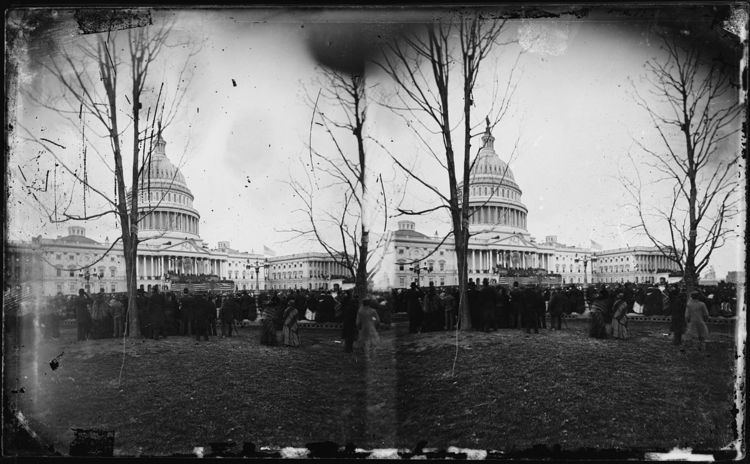The Forty-third United States Congress was a meeting of the legislative branch of the United States federal government, consisting of the United States Senate and the United States House of Representatives. It met in Washington, D.C. from March 4, 1873 to March 4, 1875, during the fifth and sixth years of Ulysses Grant's presidency . The apportionment of seats in the House of Representatives was based on the Ninth Census of the United States in 1870. Both chambers had a Republican majority.
September 18, 1873: New York stock market crash triggered the Panic of 1873, part of the Long DepressionNovember 4, 1874: United States House of Representatives elections, 1874 -Democrats regained control of the U.S. House of Representatives for the first time since 1860November 25, 1874: United States Greenback Party established as a political party, made primarily of farmers financially hurt by the Panic of 1873June 23, 1874: Poland Act, 18 Stat. 253January 14, 1875: Specie Payment Resumption Act ch. 15, 18 Stat. 296March 1, 1875: Civil Rights Act of 1875, (Butler-Sumner Act) 18 Stat. 335March 3, 1875: Tariff of 1875March 3, 1875: Page Act of 1875, 18 Stat. 477March 18, 1874: Hawaii signed a treaty with the United States granting exclusive trading rights.The count below identifies party affiliations at the beginning of the first session of this Congress, and includes members from vacancies and newly admitted states, when they were first seated. Changes resulting from subsequent replacements are shown below in the "Changes in membership" section.
Before this Congress, the 1870 United States Census and resulting reapportionment changed the size of the House to 292 members.
President: Henry Wilson (R)President pro tempore: Matthew H. Carpenter (R)Henry B. Anthony (R), elected January 25, 1875.Speaker: James G. Blaine (R)Republican Conference Chair: Horace MaynardDemocratic Caucus Chairman: William E. NiblackThis list is arranged by chamber, then by state. Senators are listed in order of seniority, and Representatives are listed by district.
Skip to House of Representatives, belowSenators were elected by the state legislatures every two years, with one-third beginning new six-year terms with each Congress. Preceding the names in the list below are Senate class numbers, which indicate the cycle of their election. In this Congress, Class 1 meant their term ended with this Congress, requiring reelection in 1874; Class 2 meant their term began in the last Congress, requiring reelection in 1876; and Class 3 meant their term began in this Congress, requiring reelection in 1878.
The names of members of the House of Representatives are preceded by their district numbers.
The count below reflects changes from the beginning of the first session of this Congress.
replacements: 5Democratic: 1 seat net gainRepublican: no net changeLiberal Republican: 1 seat net lossdeaths: 3resignations: 3interim appointments: 1vacancy: 1Total seats with changes: 7replacements: 15Democratic: 3 seat net gainRepublican: 4 seat net lossLiberal Republican: 1 seat net gaindeaths: 8resignations: 5contested election: 4Total seats with changes: 19Lists of committees and their party leaders.
AgricultureAppropriationsAudit and Control the Contingent Expenses of the SenateCivil Service and RetrenchmentClaimsCommerceDistributing Public Revenue Among the States (Select)District of ColumbiaEducation and LaborFinanceForeign RelationsIndian AffairsJudiciaryManufacturesMilitary AffairsMines and MiningMississippi River Levee System (Select)Naval AffairsOrdnance and War Ships (Select)Outrages in Southern States (Select)Pacific RailroadPatentsPensionsPost Office and Post RoadsPrivate Land ClaimsPrivileges and ElectionsPublic LandsRailroadsRemoval of Political Disabilities (Select)RetrenchmentRevision of the LawsRevolutionary ClaimsRules (Select)Tariff Regulation (Select)TerritoriesTransportation Routes to the Seaboard (Select)WholeAccountsAgricultureAppropriationsAlabama Affairs (Select)Arkansas Affairs (Select)Banking and CurrencyClaimsCoinage, Weights and MeasuresCommerceDistrict of ColumbiaEducation and LaborElectionsExpenditures in the Interior DepartmentExpenditures in the Justice DepartmentExpenditures in the Navy DepartmentExpenditures in the Post Office DepartmentExpenditures in the State DepartmentExpenditures in the Treasury DepartmentExpenditures in the War DepartmentExpenditures on Public BuildingsFreedmen's AffairsForeign AffairsIndian AffairsInvalid PensionsManufacturesMileageMilitary AffairsMilitiaMines and MiningNaval AffairsPacific RailroadsPatentsPost Office and Post RoadsPublic Buildings and GroundsPublic ExpendituresPublic LandsRailways and CanalsRevision of LawsRules (Select)Standards of Official ConductTerritoriesWar ClaimsWays and MeansWholeConditions of Indian Tribes (Special)Enrolled BillsInquire into the Affairs of the District of ColumbiaArchitect of the Capitol: Edward ClarkLibrarian of Congress: Ainsworth Rand SpoffordChaplain: John P. Newman (Methodist)Byron Sunderland (Presbyterian), elected December 8, 1873Secretary: George C. GorhamSergeant at Arms: John R. FrenchChaplain: John G. Butler (Presbyterian)Clerk: Edward McPhersonClerk at the Speaker’s Table: John M. BarclayDoorkeeper: Otis S. BuxtonPostmaster: Henry SherwoodSergeant at Arms: Nehemiah G. Ordway 
